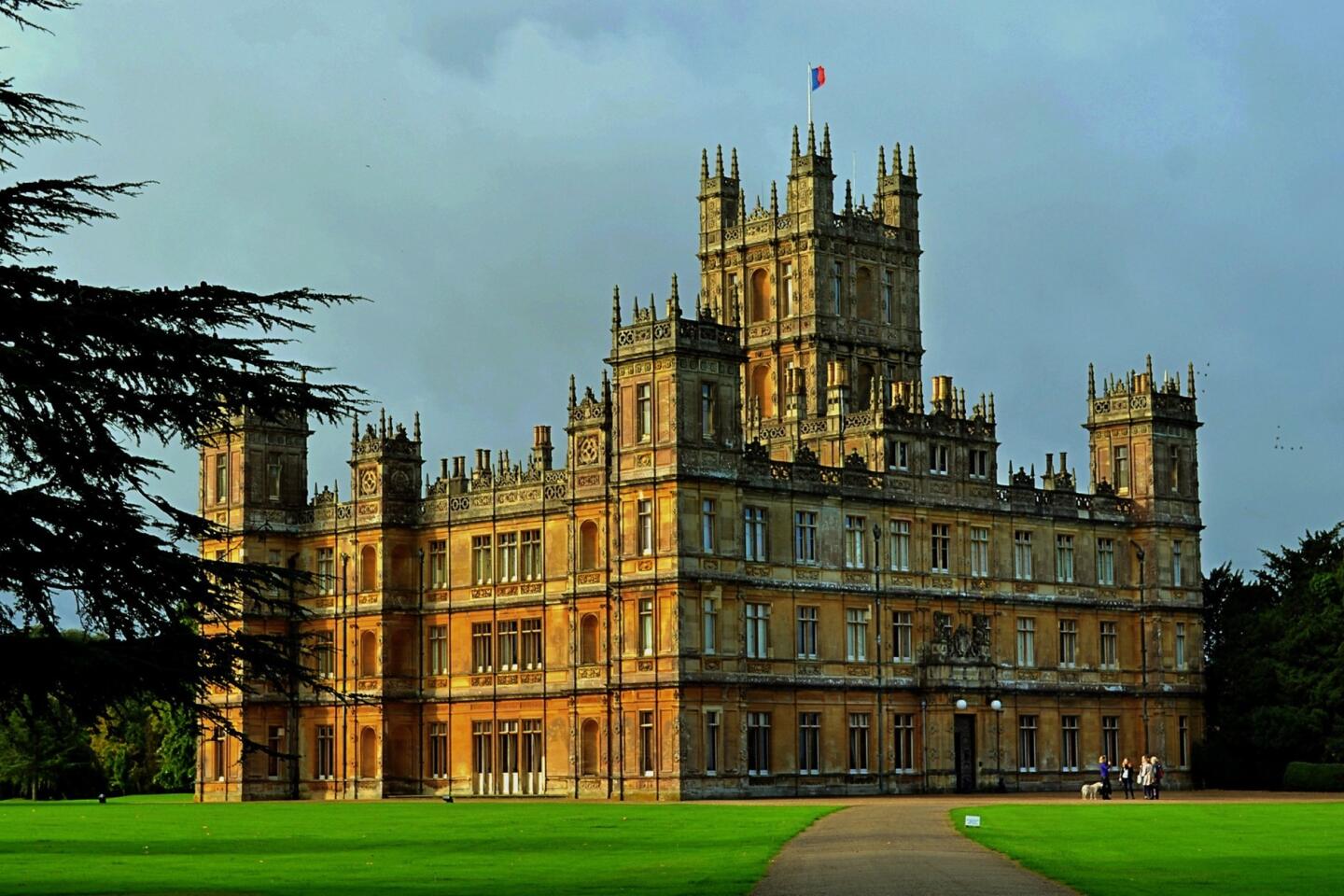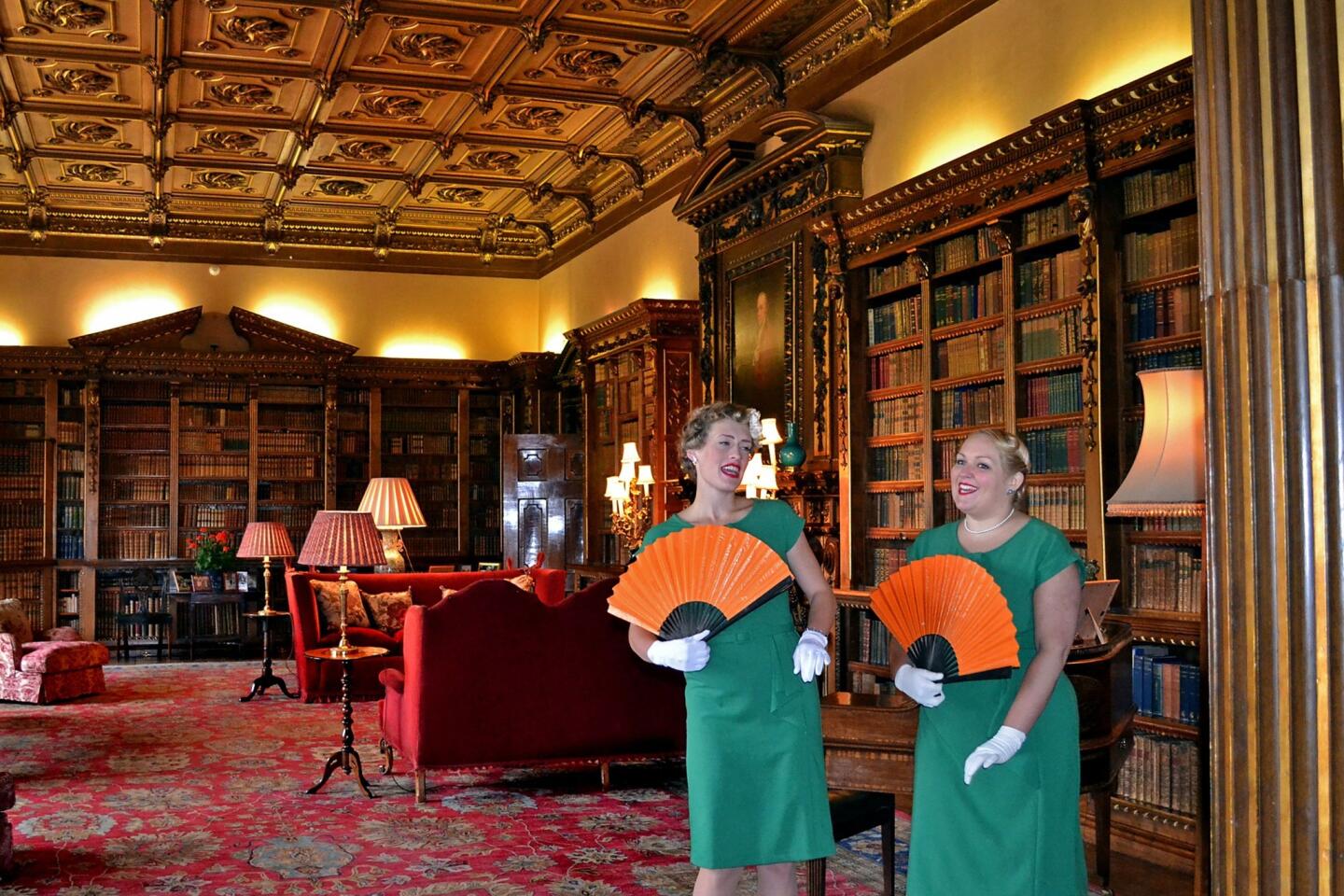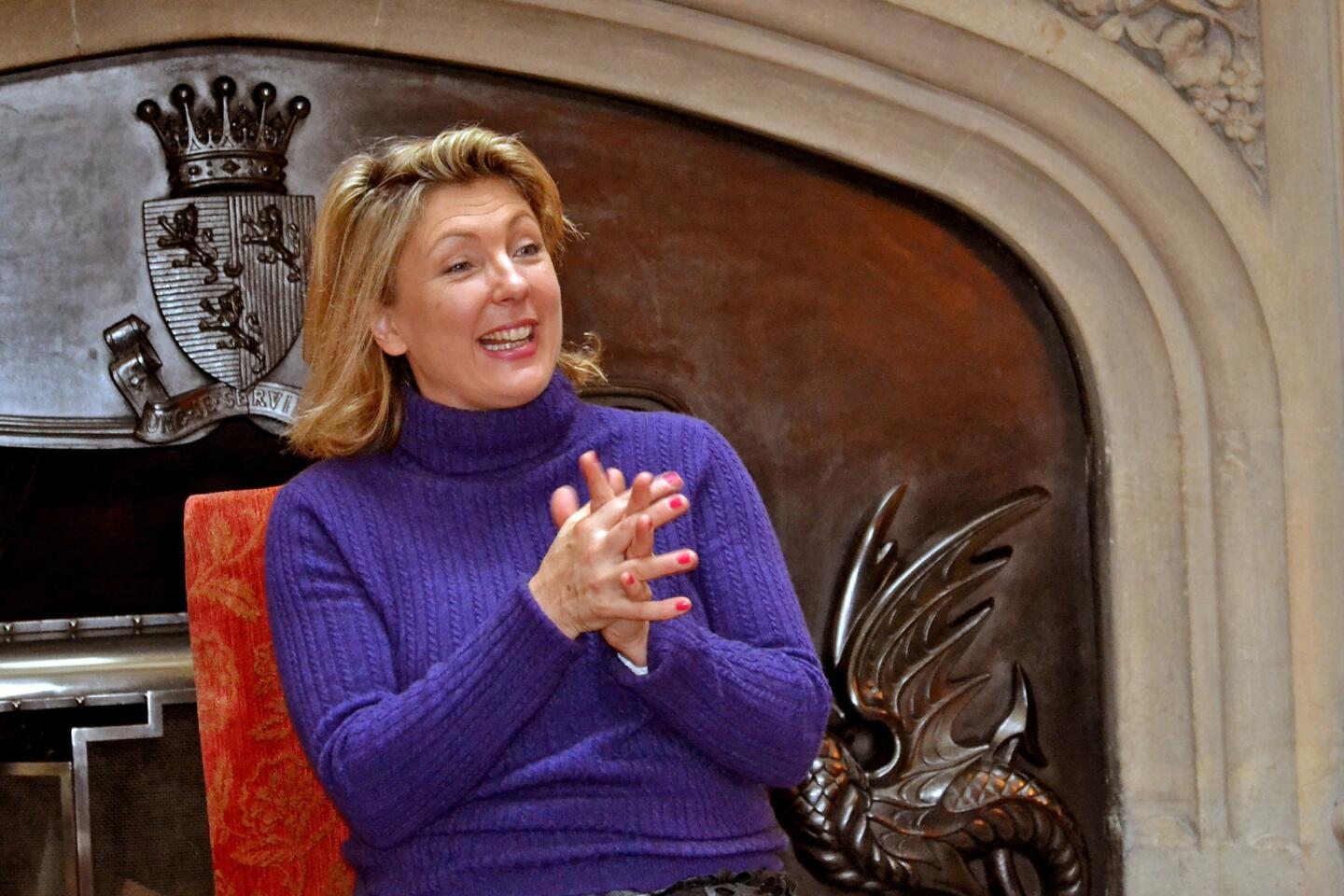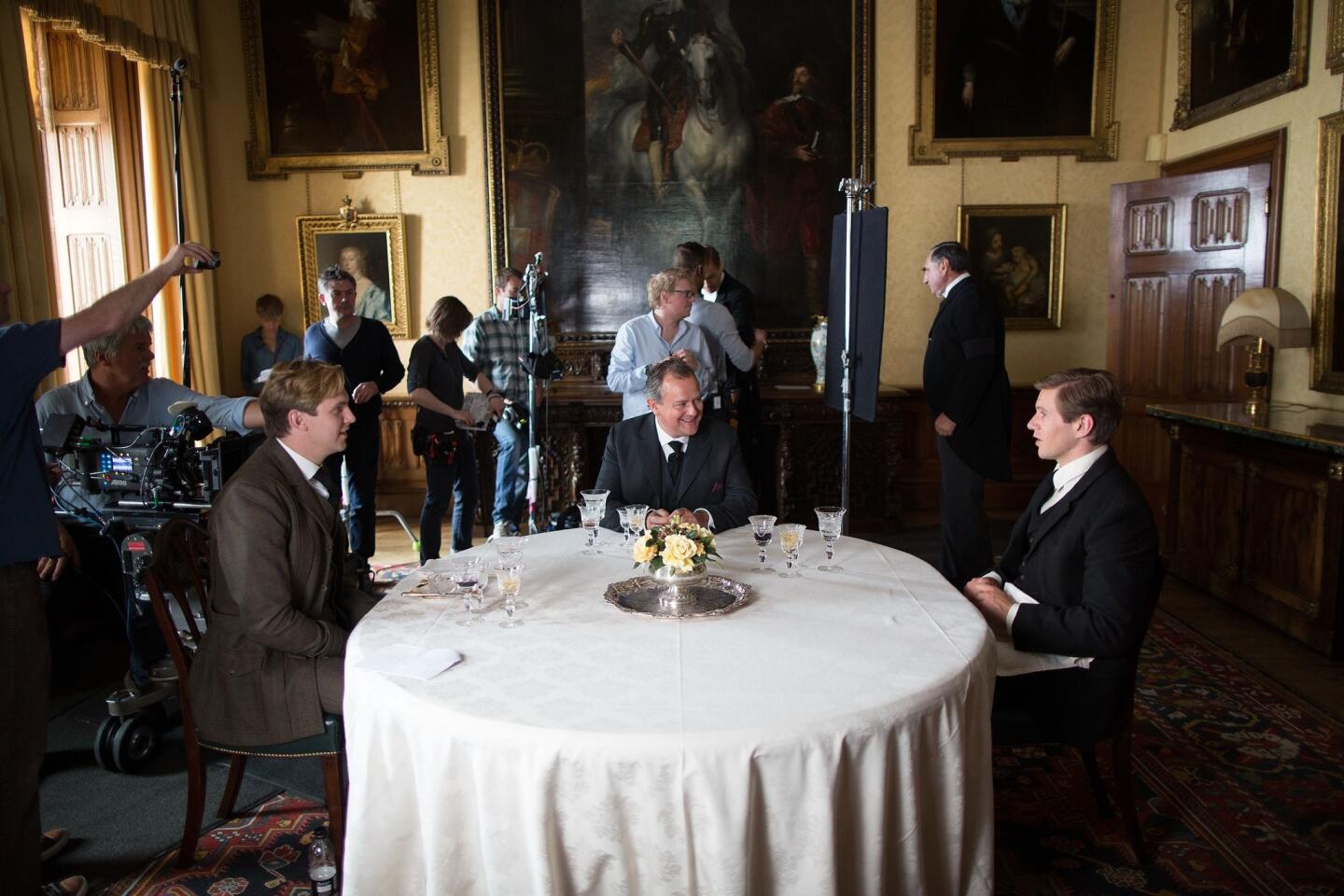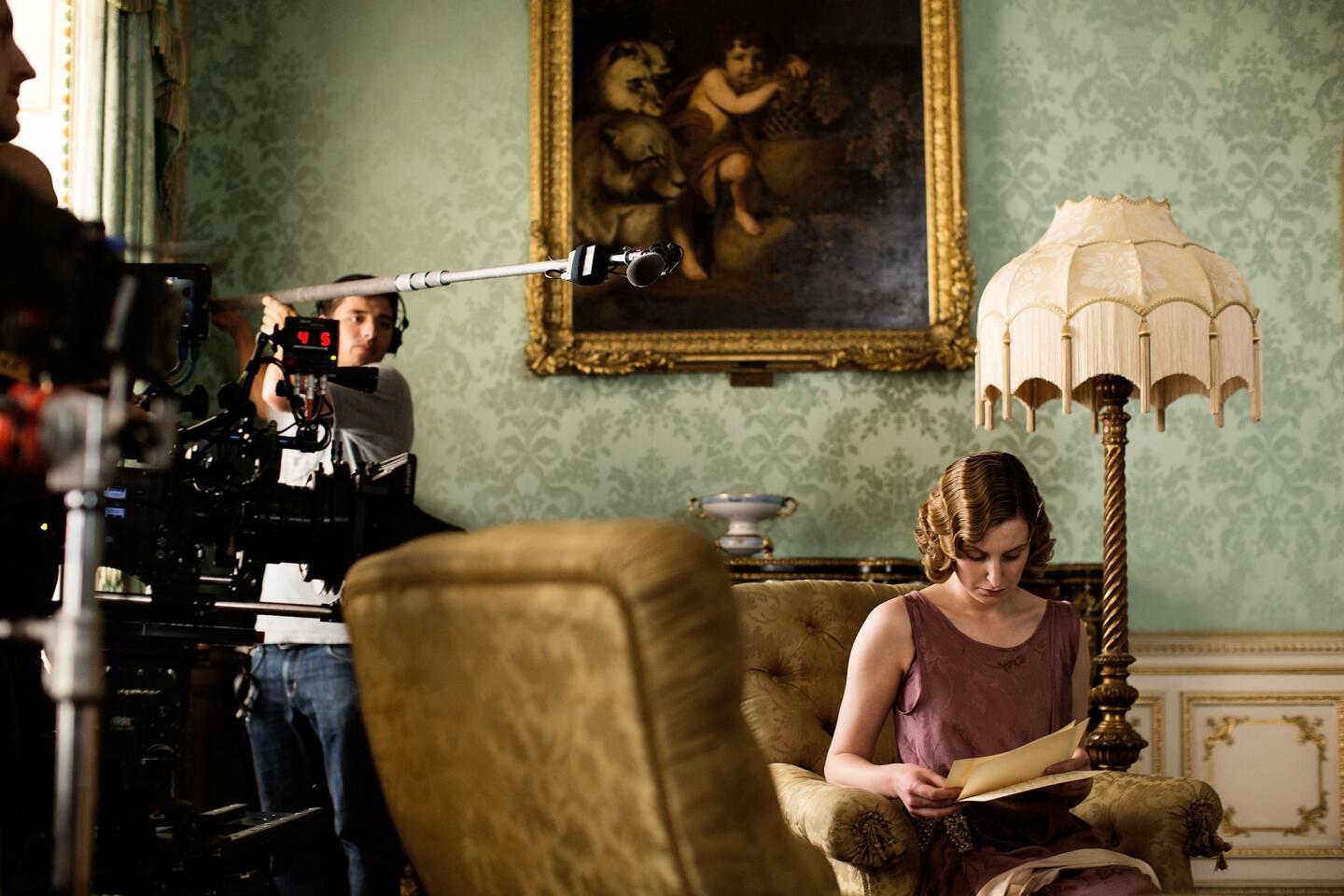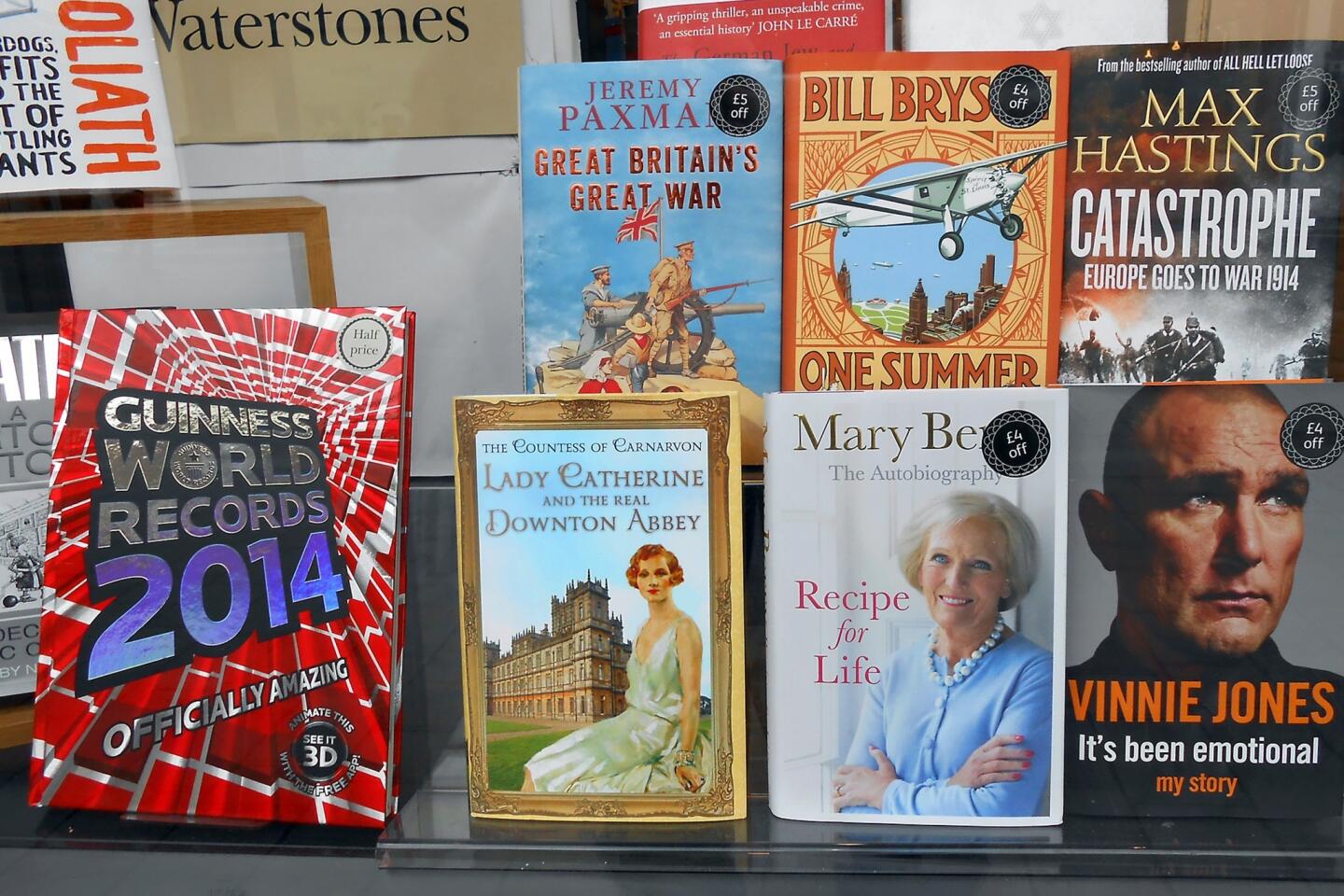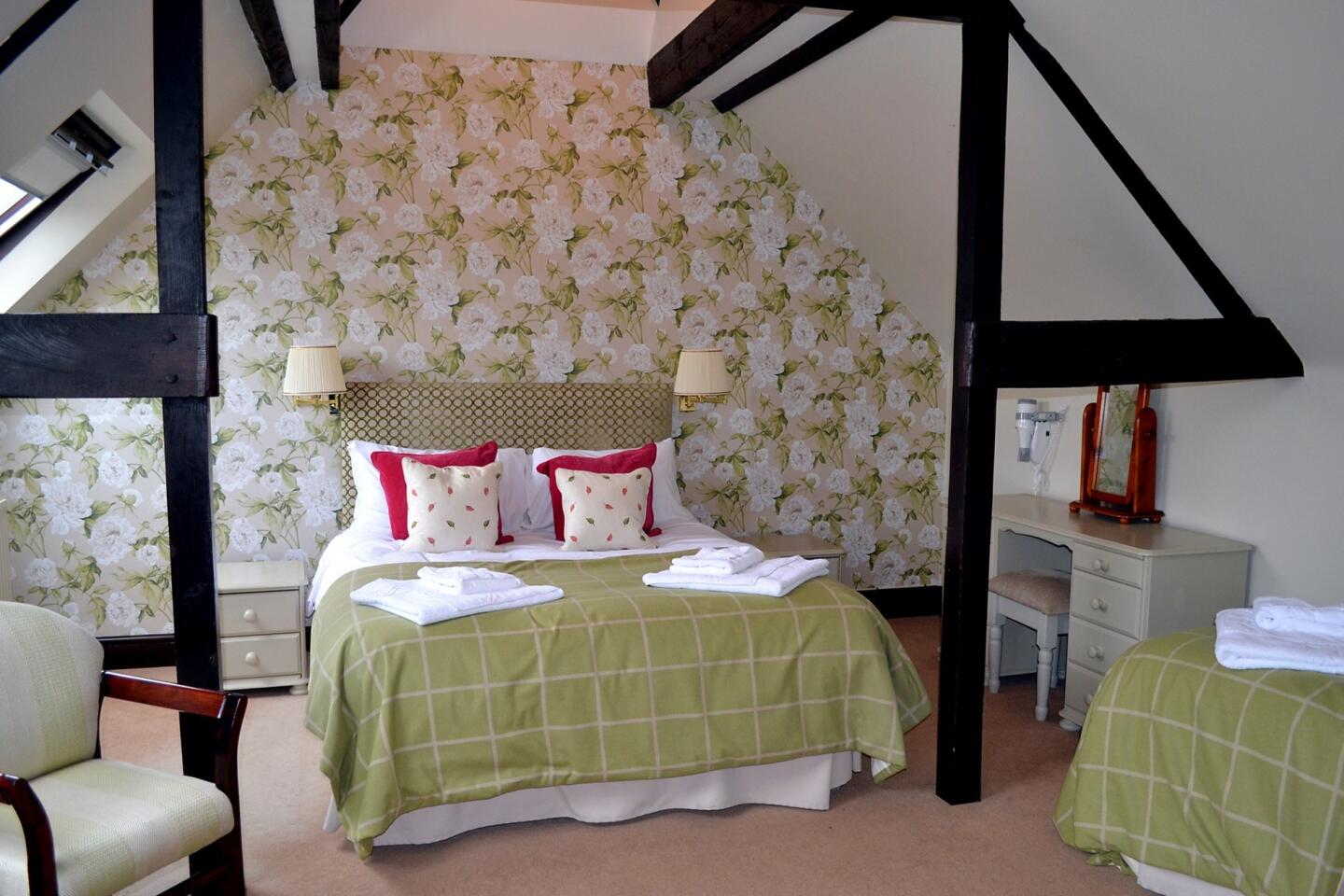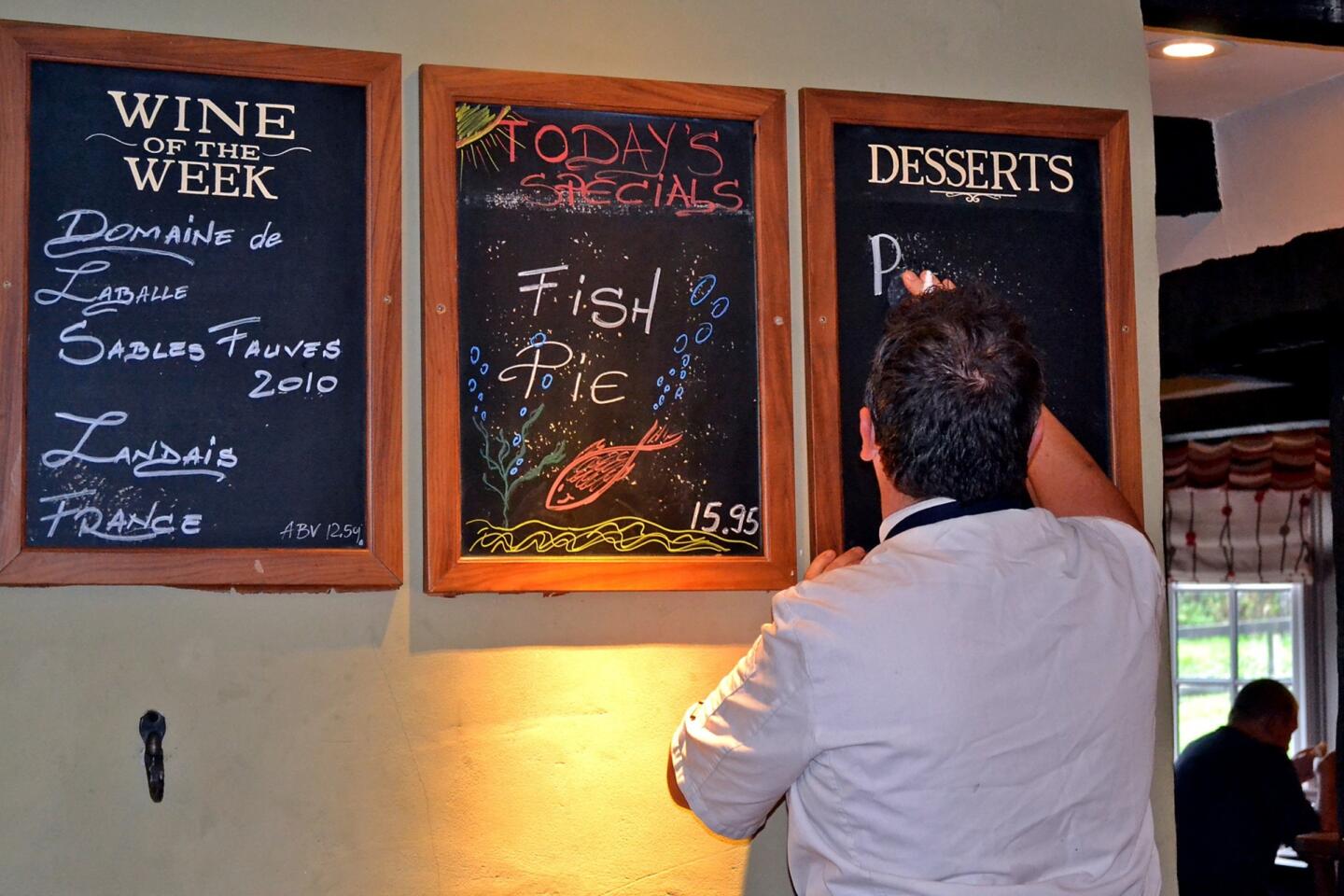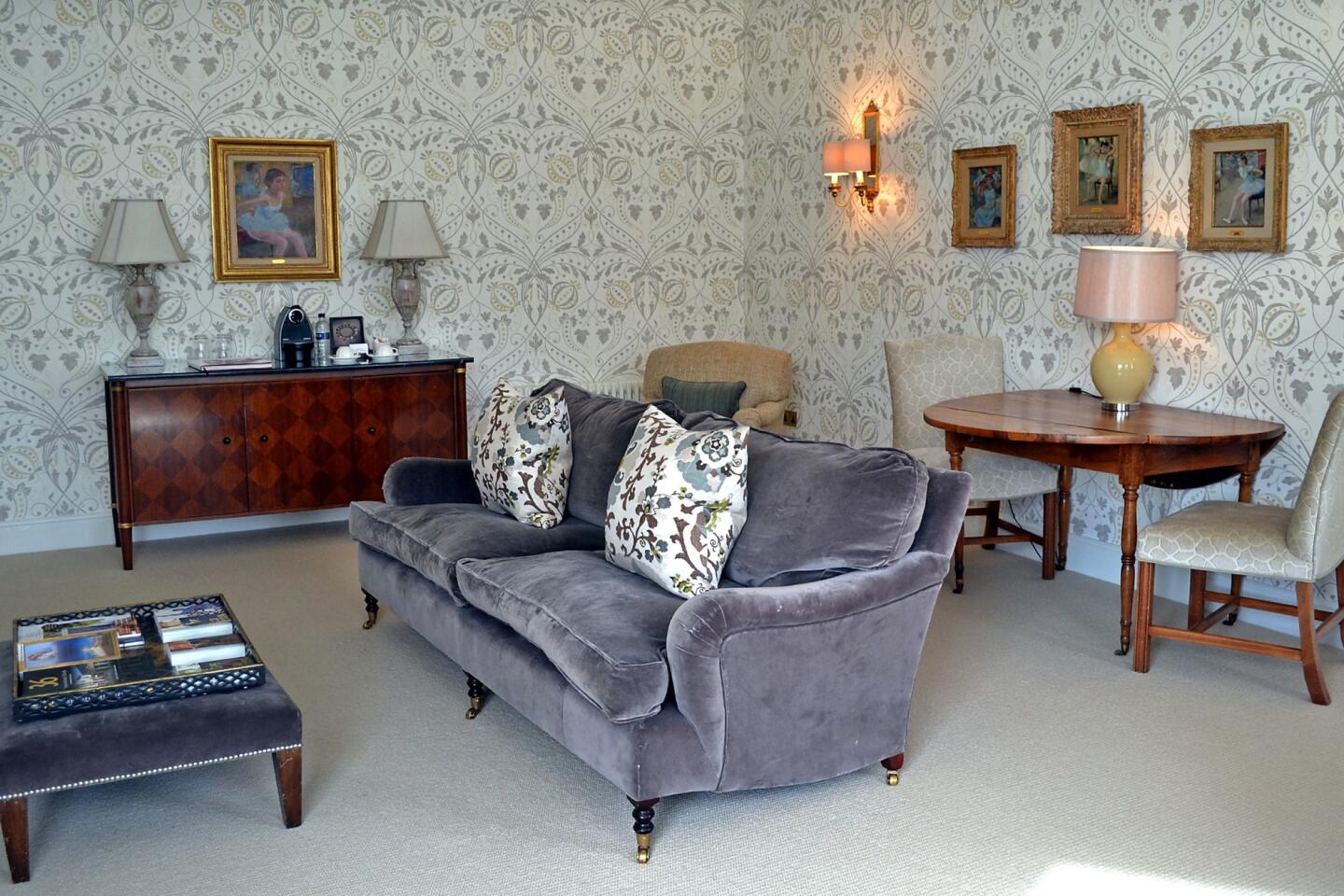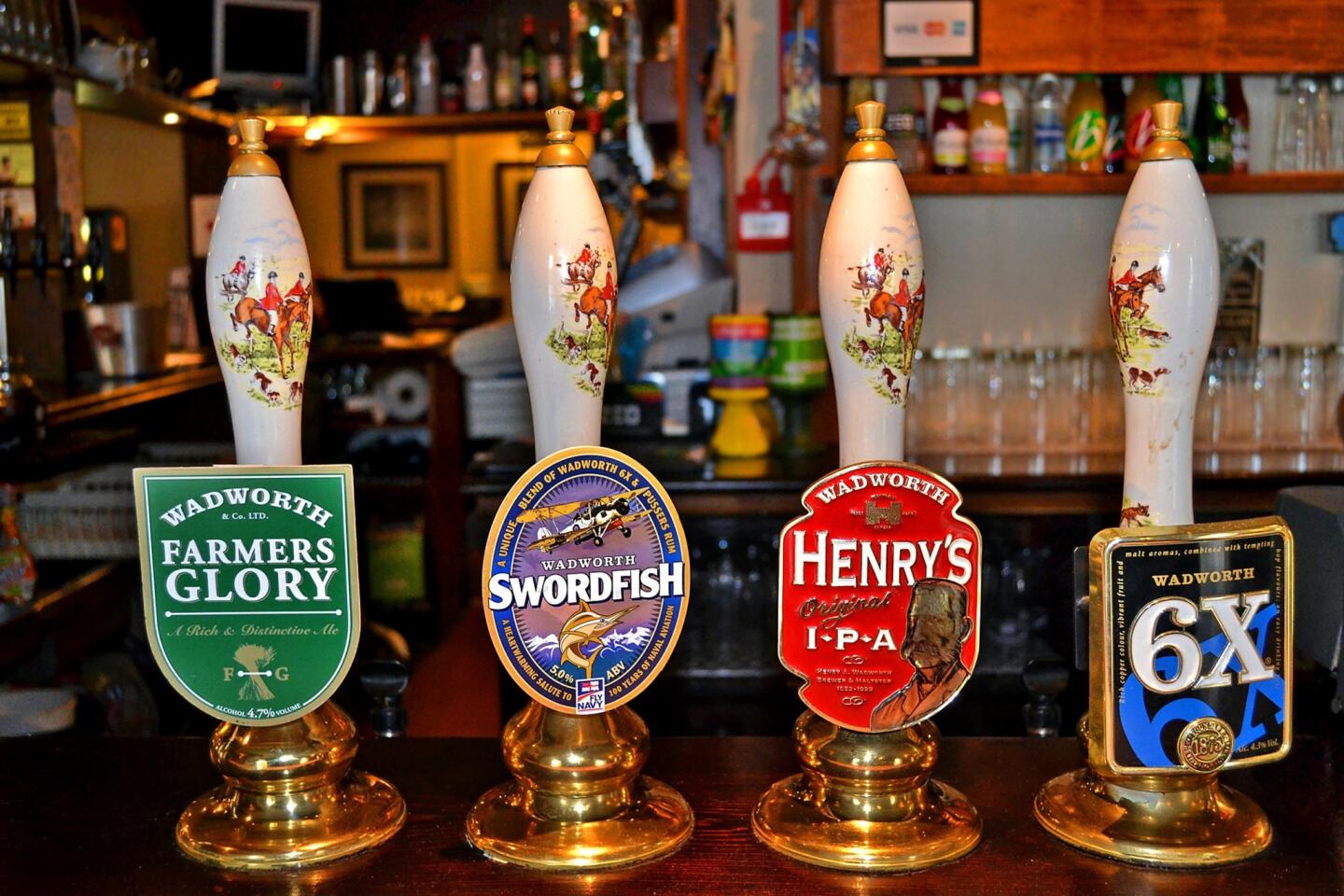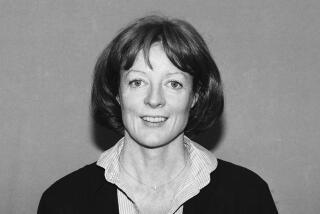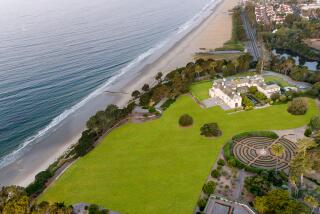Under the spell of Highclere Castle and ‘Downton Abbey’
- Share via
NEWBURY, England — He is a farmer, she says, and she is a farmer’s wife. They are active in their community. She writes a bit on the side, her writing room only recently having been wired for electricity.
On my recent visit to her home, she was warm and welcoming. Her yellow Lab, Bella, followed her closely as her mistress ushered visitors into the house.
And oh my. What a house. Two hundred rooms. Forty bedrooms. Silk wallcoverings in one room, 16th century Spanish leather wallcoverings in another. An original Van Dyck. A display on Egyptology, in honor of one of the previous occupants who just happened to have discovered King Tut’s tomb.
Hundreds of other treasures make it abundantly clear that you are not in Kansas anymore.
You are, instead, on the set of “Downton Abbey,” but it’s not a set at all. It is Highclere Castle, and when Season 4 begins Sunday for American viewers of the wildly popular PBS show, it is this magnificent home they will see, outside and partly inside too.
The farmer’s wife, as she called herself — the Countess of Carnarvon — has tried hard to keep it a home, she says, rather than a museum, although she and her husband, the Eighth Earl of Carnarvon and their son live elsewhere.
But Highclere isn’t exactly a home, at least, not the way we might think of one. I may display pictures of my godmother in my home, but she is not Queen Elizabeth II, the current earl’s godmother whose photo is on display. I have a desk, but it didn’t belong to Napoleon Bonaparte. My dishes are not Meissen china.
To be at Highclere, as I was in October with a group of foreign reporters, is to be caught in the spell of the fairy-tale story of the castle that gave rise to “Downton Abbey.” The enchantment stretches beyond the 5,000 acres of the estate, where sheep graze on the green hills and wheat, oats and other crops are grown, to the quaint town of Newbury and maybe, I hoped, to the promise of a Hollywood-style tidbit to tantalize friends and fans at home.
A cab deposited me and my sister at the White Hart Inn in Hamstead Marshall, about four miles from Newbury. The family room where we dropped our bags was up a set of creaking steps in a converted carriage house — plenty of room to stretch out (a double and single bed), a minty-green color scheme and, best of all, a bath in which you didn’t have to hold your breath to move around.
Back in the lobby/pub/restaurant, we quizzed manager Richard Huxtable about all things “Downton.” He isn’t a follower.
“It’s a period drama,” he said, though I wasn’t sure whether it was the period (perhaps too modern for the manager of a 16th century inn) or the drama (perhaps Lady Edith does go on a bit much) that he disdained.
Paul Westbrook doesn’t watch it either, which also disappointed me because his car service often transports the “Downton” actors. He drove us several places, and we expected some gossipy bits about the cast. They are “lovely” people, he says — Maggie Smith, who plays the acid-tongued dowager countess of Grantham; Elizabeth McGovern, the American-born countess of Grantham; her TV spouse, Hugh Bonneville, the earl; and Shirley MacLaine, the American mother of the countess.
Did I sense some classism here? There was, after all, no mention of the help. Nothing of Lesley Nicol (Mrs. Patmore, the cook) or Phyllis Logan (Mrs. Hughes) or Rob James-Collier (the maybe mellowing Thomas). But no, it’s because the downstairs scenes involving the help are shot not at Highclere but at Ealing Studios in London.
The most revealing thing Westbrook would say was that at least one cast member enjoys a nip after work.
At last, but my glee was short-lived. Pub culture in Britain is so ingrained that, upon reflection, I realized this was hardly a stinging indictment.
Just to be sure, we stopped at the Lion, a Newbury pub, hoping for a bit of dirt. We certainly didn’t find it here, not literally and not figuratively. The Lion, like the rest of Newbury, has a Main Street U.S.A. quality about it. Among the shops, flower baskets, trailing bits of greenery, hang from the walls. The traffic along the main drag is controlled by bollards, posts that can be raised or lowered, and on that day, nary a car buzzed by. It was all very quiet, very pretty and a tad unnerving.
Undaunted, I thought I could pry some juicy detail from Tony Sellers, the co-owner of the Lion.
Not a chance. He doesn’t watch “Downton” either and said he wouldn’t know a cast member if he saw one, which he was pretty sure he hadn’t. Steve Lane, who was then running the restaurant at the Lion, was no help. Not a member of “Downton” Nation and, like Sellers, too kind for scurrilous chatter.
Curses. Where was the damaging drama?
We found drama but not the damaging kind at the Watermill West Berkshire Playhouse (www.watermill.org.uk), where we caught a production of “Sherlock’s Last Case.” The plays at the Watermill, which derives its name from its onetime occupation, are widely praised; the Daily Telegraph called this production “as strange and satisfying as a trompe-l’oeil.” Christopher Godwin as Sherlock Holmes and Adam Kotz as Watson were pitch perfect, and, as my ever-wise sibling noted, “The English accents weren’t fake.”
The playhouse’s setting matched the gentleness of the countryside: swans on the nearby creek and ducks and geese strolling the grounds in the gloaming, the slightly musty smell of the building, just right for a bit of theater before seeing the place whose drama drew me in the first place and where, at last, I would find my kiss-and-tell moment.
Countess as greeter
Westbrook picked me up the following morning and drove the five or so miles to Highclere from Hamstead Marshall. As I walked to the front of the castle, 400-year-old cedars of Lebanon to the left, a sign reminding drivers to “stay off the verges” (grassy border) to the right, I saw a woman out front, ready to greet guests. Some sort of retainer, I imagined.
Because, after all, how often do you encounter a countess in the driveway?
Apparently at least once in a lifetime.
Dressed in purple sweater, a black skirt and boots, the Countess of Carnarvon willingly posed for pictures (at one point, she laughingly asked photographers whether they might be oversaturated with photos of her), then led the media past the English bobby at the front door.
Julian Fellowes, the creator, writer and executive producer of “Downton,” is a family friend, and it was Highclere he conjured when he envisioned the series. One glance explains why. The library, where the fictional Crawley family’s serious discussions seem to occur, is as red and gold and glowing as it appears on-screen.
Guide Molly Breakspear took us through the house, each room seemingly grander than the next: the dining room, where 12 leaves can be inserted into the table and 40 people can be seated (“They do seem to spend a good bit of time at the dining table,” she says), down the 150-year-old grand staircase, from which cast members seem to materialize and de-materialize with some frequency; to the bedrooms, where dalliances occur. (Yes, Lady Mary, I am talking about you and the Turk, but we forgave you when you finally realized Matthew was the one for you.)
Some of the real events of Highclere inform the series. Lady Almina, the wife of the fifth earl and the illegitimate daughter of millionaire banker Alfred de Rothschild, turned the house into a hospital during World War I, just as happened on “Downton.”
The constant worry about money and how to keep Highclere/Downton a going concern has played a role in real life and in the alternate universe of the series. Lady Almina brought half a million pounds — about $21 million in today’s money — to her marriage to the fifth earl, George Edward Stanhope Molyneux Herbert. Her money financed his explorations in Egypt, and late in November 1922, he and Howard Carter discovered the entrance that would lead to Tutankhamen’s tomb.
Six months later, he was dead, reinforcing the notion of the curse of Tut.
Castle upkeep
The bigger curse was, perhaps, the death duty, the inheritance tax on the property that fell to the sixth earl to pay. His mother’s fortune was largely gone so priceless artifacts were sold, to his dismay.
Breakspear conveyed all of this — and more — as she shuttled us among the rooms. Not all are used in the series, but if you visit, you will recognize the ones that are because they look largely the same. Some things are put away — that Meissen china, for instance, because, the countess says with a laugh, “I don’t want them to risk [breaking] that, nor do I want to risk them having broken it.”
The film crew is so fastidious “you can’t even tell they’ve been here,” Breakspear says. And that is about as much as she gives away because the volunteers, who range from 16 to 89, are damnably discreet.
The countess was slightly more forthcoming. After the group joined her in the salon of the Spanish leather walls, she settled into a chair as Bella lay at her feet. The questions from the media were scattershot, as varied as Kiri Te Kanawa’s role in Season 4 and the countess’ take on inheritance taxes.
All of it complicated by the castle. Does she ever wish she lived in semi-detached home? “When I married, I think, I didn’t look ahead,” she said. “We’re not given a crystal ball … nor did I realize quite how much work was required. But I like hard work.”
Which is good because she has plenty of it. She and the earl have been steadily repairing when they can, replacing when necessary in a home that dates to 1679 and was reconfigured by Charles Barry, who, fresh from remodeling the houses of Parliament, turned it into Highclere in the mid-1800s.
Amid the pressures of running this confection, the current countess has managed to write two remarkable books, whose historic detail reflects time spent absorbing diaries and letters and other historic documents: “Lady Almina and the Real Downton Abbey,” a 2011 bestseller that focused on the life and times of the Egypt-obsessed earl and the wife who financed his exploits, and “Lady Catherine, the Earl, and the Real Downton Abbey,” published in the U.S. in October, which picks up where “Almina” left off.
There is no dirt on the “Downton” cast and crew from the current countess, who clearly sympathizes with the tedium of filming: “Twelve hours of standing around in curlers for five minutes of film,” she says. But “Downton” is a marvelous marketing tool for Highclere: “Look, you’re all here!” she says with a laugh that frequently honeys her words.
And it’s true. About 60,000 people a year visit from all over the world; tickets (which may include access to the grounds that we didn’t get to explore) are already sold out for the spring.
Finally, amid the talk of the house and the work and the writing, the moment of misbehavior by a cast member look-alike. Bella (who resembles the dog-napped Isis in the series) awakened, trotted up to me, licked my hand, then planted a big wet one on my lips.
Not exactly the scandal I hoped for — but the canine kiss would have to stand in for something more scintillating.
Against the backdrop of this glorious room, the graciousness of the lady of the house and the grandeur of the history, that smooch seemed a right note. Sometimes silly, sometimes serious, “Downton” invites us into a world that we don’t inhabit but we do recognize. Dogs get lost (that was nasty, Thomas), loves are lost and lives are lost. The genius of the show is that we cannot help but care about all of it.
“The more you understand,” the countess says, quoting a German philosopher, “the more you love.”
Until the series ends and for a long time afterward, our hearts will be here.
More to Read
Sign up for The Wild
We’ll help you find the best places to hike, bike and run, as well as the perfect silent spots for meditation and yoga.
You may occasionally receive promotional content from the Los Angeles Times.
